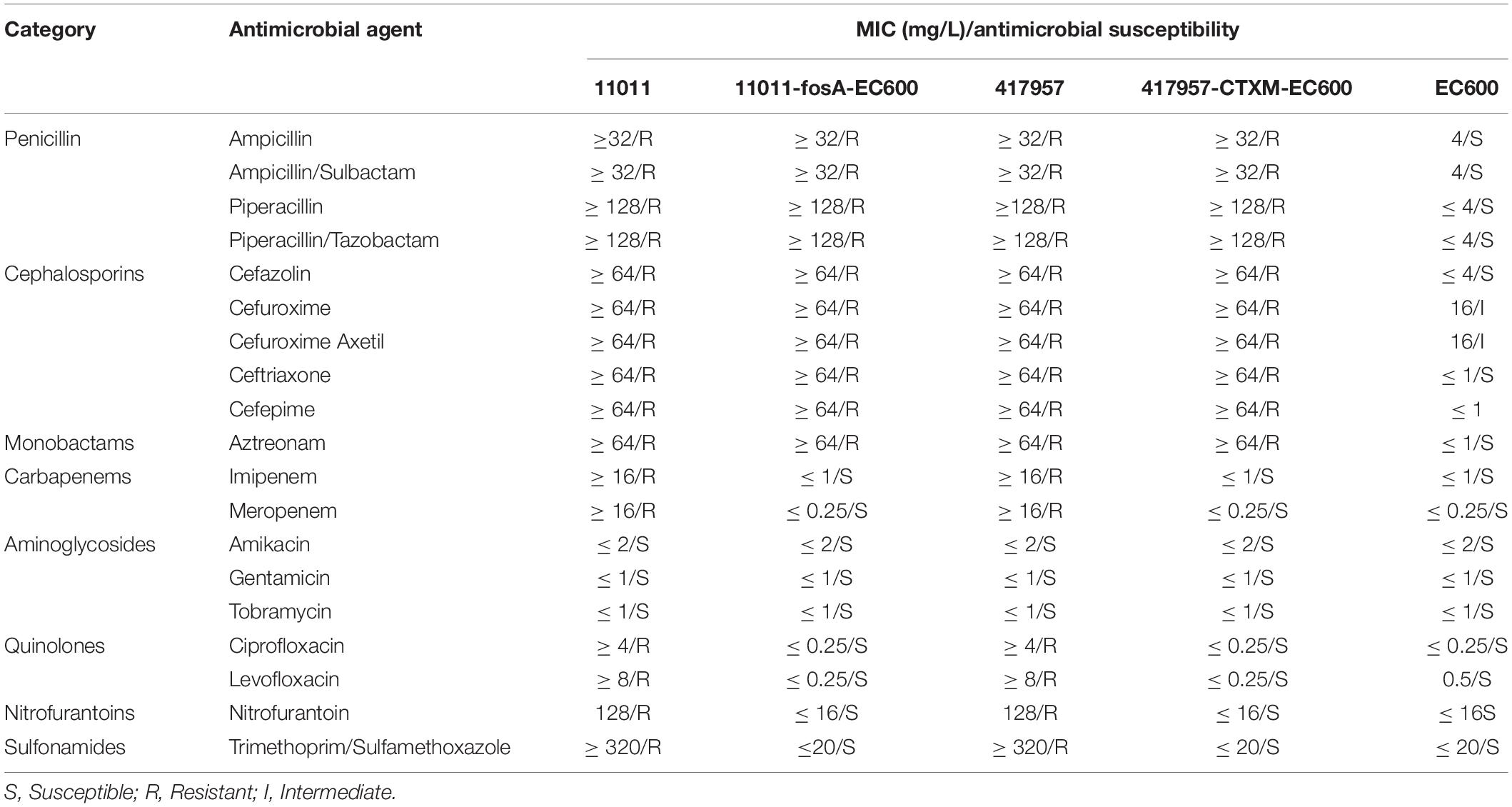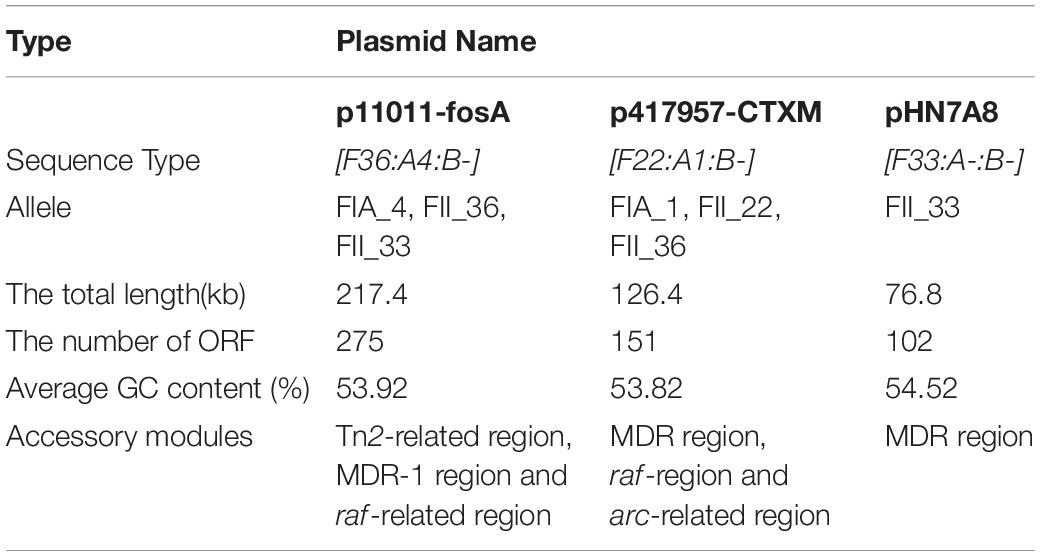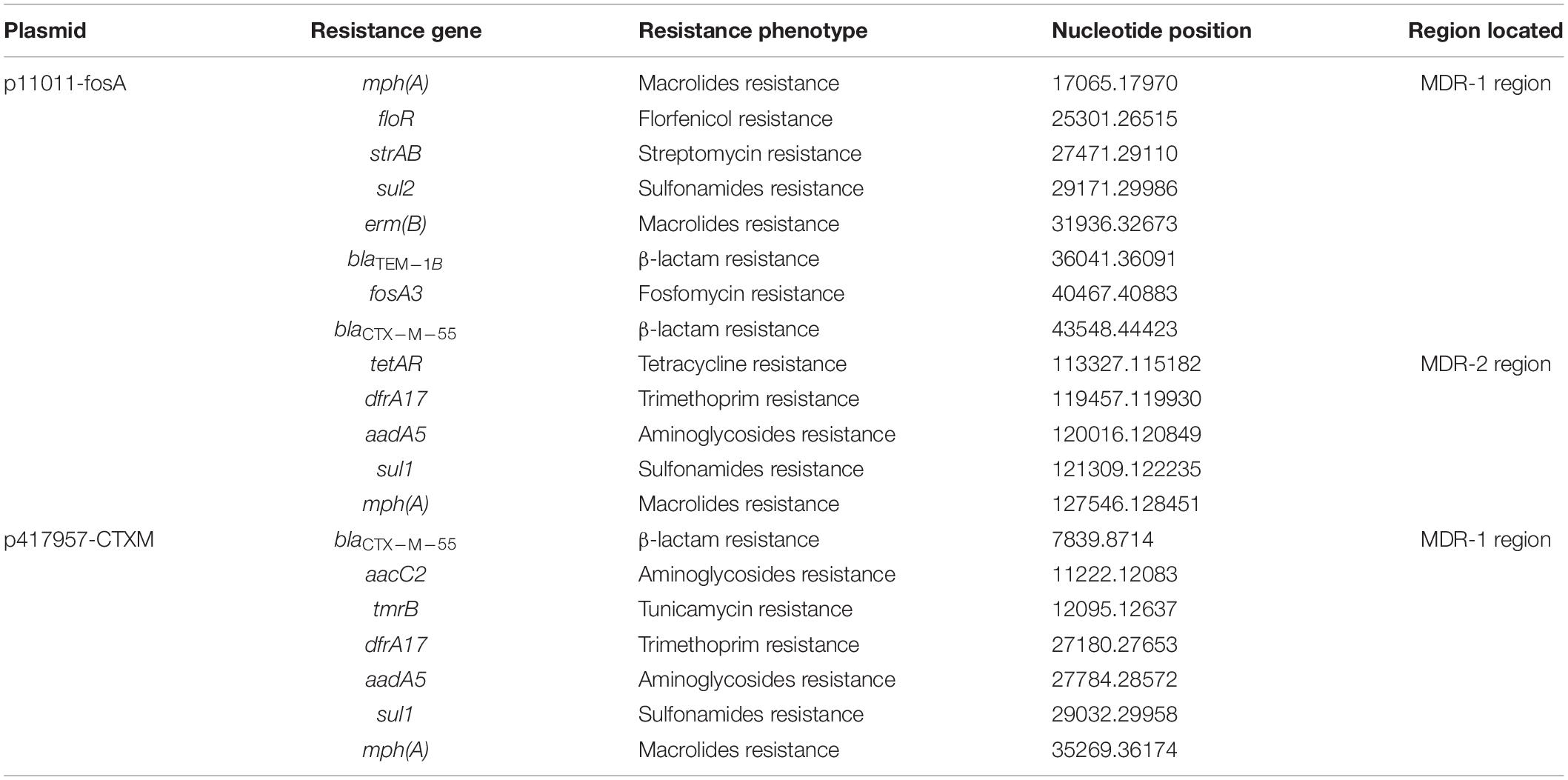- 1Zhejiang Provincial Center for Animal Disease Prevention and Control, Hangzhou, China
- 2Key Laboratory of Food Quality and Safety, School of Food Science and Biotechnology, Zhejiang Gongshang University, Hangzhou, China
This research aimed to investigate the presence and transferability of the extended-spectrum β-lactamase resistance genes to identify the genetic context of multi-drug resistant (MDR) loci in two Escherichia coli plasmids from livestock and poultry breeding environment. MICs were determined by broth microdilution. A total of 137 E. coli resistant to extended-spectrum β-lactam antibiotics were screened for the presence of the ESBL genes by PCR. Only two E. coli out of 206 strains produced carbapenemases, including strain 11011 that produced enzyme A, and strain 417957 that produced enzyme B. The genes were blaKPC and blaNDM, respectively. The plasmids containing blaCTX–M were conjugatable, and the plasmids containing carbapenem resistance gene were not conjugatable. Six extended-spectrum β-lactamase resistance genes were detected in this research, including blaTEM, blaCTX–M, blaSHV, blaOAX–1, blaKPC, and blaNDM, and the detection rates were 94.89% (130/137), 92.7% (127/137), 24.81% (34/137), 20.43% (28/137), 0.72% (1/137), and 0.72% (1/137), respectively. Two conjugative lncFII multi-resistance plasmids carrying blaCTX–M, p11011-fosA and p417957-CTXM, were sequenced and analyzed. Both conjugative plasmids were larger than 100 kb and contained three accessory modules, including MDR region. The MDR region of the two plasmids contained many antibiotic resistance genes, including blaCTX–M, mph (A), dfrA17, aadA5, sul1, etc. After transfer, both the transconjugants displayed elevated MICs of the respective antimicrobial agents. A large number of resistance genes clusters in specific regions may contribute to the MDR profile of the strains. The presence of mobile genetic elements at the boundaries can possibly facilitate transfer among Enterobacteriaceae through inter-replicon gene transfer. Our study provides beta-lactam resistance profile of bacteria, reveals the prevalence of β-lactamase resistance genes in livestock and poultry breeding environment in Zhejiang Province, and enriches the research on IncFII plasmids containing blaCTX–M.
Introduction
Escherichia coli is the most common conditional pathogen in the culture environment, which can cause varying degrees of infection in livestock and poultry. These Escherichia coli strains, which contain a large number of antibiotic resistant genes, accumulate in humans and farmed animals, and are released into the environment via feces. They continue to contaminate the human food environments (e.g., agricultural, aquatic, and livestock products) as well as livestock and poultry breeding environment (Sajjad et al., 2011; Chajȩcka-Wierzchowska et al., 2014; Yano et al., 2014; Blaak et al., 2015; Liao et al., 2015). Finally, multidrug-resistant E. coli accumulate in the human body through the food chain (Wellington et al., 2013).
Extended-spectrum β-lactamase (ESBLs) is currently considered one of the world’s major public health problems. In Enterobacteriaceae, E. coli causes the most infections and is the main species producing ESBL (Bradford, 2001). Many genes are able to produce ESBLs that they can hydrolyze cephalosporins, penicillin, and monocyclic β-lactam antibiotics aztreonam (Kanayama et al., 2010). β-lactamases have been divided into four major classes (A, B, C, and D) according to the amino acid similarity. β-lactamases of classes A, C, and D are serine β-lactamases, whereas those of class B are metallo-β-lactamases (Paterson and Bonomo, 2005). Initially, the most prevalent ESBLs were TEM or SHV variants possessing amino acid substitutions (Sivaraman et al., 2021). blaCTX–M is one of the most important ESBL genes, which has been found in several conjugative plasmids of Enterobacteriaceae (Abera et al., 2016; Abraham et al., 2018). IncF plasmids are usually low copy number plasmids, > 100 kb in size, and typically carry fused replicons with multiple replication initiation genes (Laura et al., 2010). The multi-replicon status is described as a means by which a plasmid with a narrow host range can replicate in a wide host range. Integrons were initially discovered because they are often associated with drug-resistant genes (Stokes and Hall, 1989). Class 1 integrons are the most frequently identified integron classes within clinical environments. This class was the first integron found, which mainly distributed on plasmids of Gram-negative bacteria (Goldstein et al., 2001). blaCTX–M gene was used as a query for BLAST search in the NCBI nucleotide sequence database, and it was found that it existed mainly in Enterobacterales. However, it is still unknown how frequently the gene occurs in the E. coli in Zhejiang Province, and the number of related IncFII plasmids containing blaCTX–M is not very high in the NCBI database. Moreover, the genetic background of blaCTX–M also needs to be further studied.
In this study, the relative abundance of the known ESBL genes in E. coli in livestock and poultry breeding environment was determined. This research provided beta-lactam resistance profile of bacteria isolated from livestock and poultry breeding environment in Zhejiang Province. Our study suggests that resistance to beta-lactam is too high in E. coli. Therefore, local farmers can possibly reduce the use of specific beta-lactam antibiotics, making a particular contribution to the reduction of local antibiotic resistance. Furthermore, two IncFII plasmids harboring blaCTX–M along with other resistance genes were analyzed to clarify the basis for dissemination. This research enriched the study of plasmids containing blaCTX–M resistance genes in the NCBI database.
Materials and Methods
Bacterial Strains
A total of 206 non-duplicate E. coli isolates were collected from 6 livestock and poultry farms in Zhejiang Province, China, 2018. A list of collected samples from feces, urine, soil, and surrounding water environment was presented in Supplementary Table 1. Colonies with a green metallic sheen growing on Eosin Methylene Blue Agar plates were initially considered E. coli strains. The isolates were identified by VITEK-2 Compact and 16S rRNA gene identification using the universal 16s primers 27F and 1492R (Lane, 1991). EC600 served as the recipient strain in conjugal transfer experiments. EC600 was resistant to rifampicin, but sensitive to ampicillin, carbapenem, quinolones, and sulfonamides.
Antimicrobial Susceptibility Testing
E. coli strains were evaluated based on the size of the inhibition zones and classified as resistant, intermediate, or susceptible according to the CLSI criteria for Enterobacteriaceae as the breakpoints were shown in Supplementary Table 2 (Institute CLSI, 2018). E. coli strains exhibiting resistance to three or more classes of antimicrobials were considered to be multi-drug resistant (MDR). E. coli ATCC 25922 served as the control.
PCR Analysis
E. coli strains were screened for the presence of the ESBLs gene by PCR using the primers listed in Supplementary Table 3 (blaGES, blaKPC, blaSME, blaIMI, etc.) and Supplementary Table 4 (blaCTX–M universal, blaCTX–M–1, blaCTX–M–2, blaCTX–M–8, blaCTX–M–9, blaCTX–M–25, etc.), as described previously (Hong et al., 2012). PCR amplification consisted of denaturation at 95°C for 5 min followed by denaturation at 94°C for 30 s, annealing at their respective annealing temperature for 30 s, and polymerization at 72°C for 40 s for a total of 30 cycles, and a final extension at 72°C for 10 min. All the PCR products were subjected to Sanger sequencing.
The Enzyme-Producing Activity of Bacteria
The enzyme-producing activity was detected by a modified Carba NP method. The carbapenems producing types of Enterobacteriaceae mainly include A, B, and D, representing KPC, NDM, and OXA-48, respectively. According to the characteristics of the above enzymes, an improved Carba NP detection method was designed to detect specific enzyme production types. Class A carbapenems were at least partially inhibited by tazobactam, while class B carbapenems (metal-β-lactamases) were inhibited by divalent cationic chelators such as EDTA. No chemical inhibitors were available for class D carbapenems. The formulas for each system and the expected outcomes of different enzyme production types were shown in Supplementary Table 5. 1705 was the control of enzyme A, and the well of substrate II and substrate IV turned yellow. 2146 was the control of enzyme B, and the wells of substrate II and substrate III turned yellow.
Conjugal Transfer Experiments
Conjugal transfer experiments were performed with rifampin-resistant E. coli EC600 used as a recipient and each of the blaCTX–M-positive 11011 and 417957 isolates as a donor. Brain Heart Infusion (BHI) was supplemented with 2.5 mg/mL rifampicin and 200 μg/L ampicillin to screen transconjugants. After incubation at 37°C for 24 h, colonies growing on these selective plates were further confirmed by antimicrobial sensitivity experiments and VITEK-2 Compact.
Sequencing and Analysis
The two conjugatable plasmids of the transconjugants 11011-EC600 and 417957-EC600 were sequenced by the Illumina MiSeq platforms. The two plasmids DNA was extracted from the transconjugants 11011-EC600 and 417957-EC600 using the Qiagen Large-Construct Kit. After extraction, the mate-pair library was constructed. Then MiSeq (Illumina, CA, United States) was used to sequence the plasmids, and Newbler 2.6 was used to assemble the Illumina read sets straight off the MiSeq. Quality control and removing low-quality data were performed with TrimMomatic 0.36 (Bolger et al., 2014). Gapfiller V1.11 is used to fill gaps (Nederbragt, 2014). Finally, Cytoscape was used to spline the sequence to obtain the final cyclized plasmids. The plasmid sequences were submitted to Rast, Genemarks, Glimmer, and Prodigal library for preliminary gene prediction then submitted to ISFinder, Integrall, ResFinder, and TN Number Registry for mobile elements (Boetzer and Pirovano, 2012). Gene organization diagrams were drawn by running a gene alignment program in Perl language (Supplementary File) with Ubuntu 18.04 LTS1 and Inkscape 0.48.1.2 The complement sequences of the two plasmids p417957-CTXM and p11011-fosA have been submitted in GenBank under accession numbers NZ_MH454107.1 and NZ_MG764548.1, respectively.
Results
Detection of the blaCTX–M Gene in Escherichia coli Strains
In this study, 206 strains of E. coli were identified by VITEK-2 Compact and the amplification of 16S rRNA gene (Supplementary Table 6). A total of 137 resistant strains to cephalosporins and carbapenems, isolated from farms, were screened for β-lactamase resistance genes (Table 1). The results showed that six extended-spectrum β-Lactamase resistance genes were detected in all antibiotic resistant strains, including blaTEM, blaCTX–M, blaSHV, blaOAX–1, blaKPC, and blaNDM. The detection rates were 94.89% (130/137), 92.7% (127/137), 24.81% (34/137), 20.43% (28/137), 0.72% (1/137), and 0.72% (1/137), respectively. Only two strains carried the carbapenemases-producing resistance gene. Strain 11011 contained blaKPC, and strain 417957 contained blaNDM, which both contained blaCTX–M antibiotic resistance gene and were selected for further investigation.
Determination of the Activity of Carbapenem
The modified Carba NP method was used to detect the type of enzyme production of related test strains. Only two strains out of 206 E. coli produced the enzymes. According to the color changes of the test strains that existed in the wells of substrate II, substrate III, and substrate IV, strain 11011 produced enzyme A and strain 417957 produced enzyme B (Supplementary Figure 1).
The blaCTX–M Gene Is Transferable
The transconjugants isolated by mating 11011 and 417957 strains with EC600 were resistant to rifampicin and ampicillin antibiotics, likely indicating plasmid transfer. According to the MIC results of wild strains and transconjugant, the resistant plasmid has been successfully introduced into the recipient bacteria (Table 2). The two transconjugants were not resistant to carbapenem but resistant to β-lactam, and both isolates carried two plasmids. It indicated that the plasmid containing blaCTX–M was conjugatable, and the plasmid containing carbapenem resistance gene was not conjugatable.
Characterization of Plasmids p11011-fosA and p417957-CTXM
As shown in Table 3 and Figure 1, the total length of plasmid p11011-fosA was 217.4 kb, contained 275 ORFs in total. The content of GC was 52.7%, and the plasmid contained three accessory modules, comprising Tn2-related region, MDR-1 region, and raf-related region. The total length of plasmid p417957-CTXM was 126.4 kb, which included 151ORFs. GC content was 51.4%, and the plasmid also contained three accessory modules, comprising MDR, raf- and arc-related regions. The plasmid backbone sequences of the two plasmids were similar to that of plasmid pHN7A8 from Klebsiella pneumoniae. The single replicon IncFII plasmid pHN7A8 (Genbank: NC_019073.1) was chosen as the reference plasmid. The length of plasmid pHN7A8 was 76.8 kb, and only contained one accessory modules-a 14.5 kb MDR region. The three plasmids consist of the backbone area and accessory modules. They were formed by inserting antibiotic resistance genes and adjacent mobile elements into different positions in the backbone area. Both plasmids p11011-fosA and p417957-CTXM contain numerous antibiotic resistance genes (Table 4), and plasmids can be transferred to EC600 by conjugation.
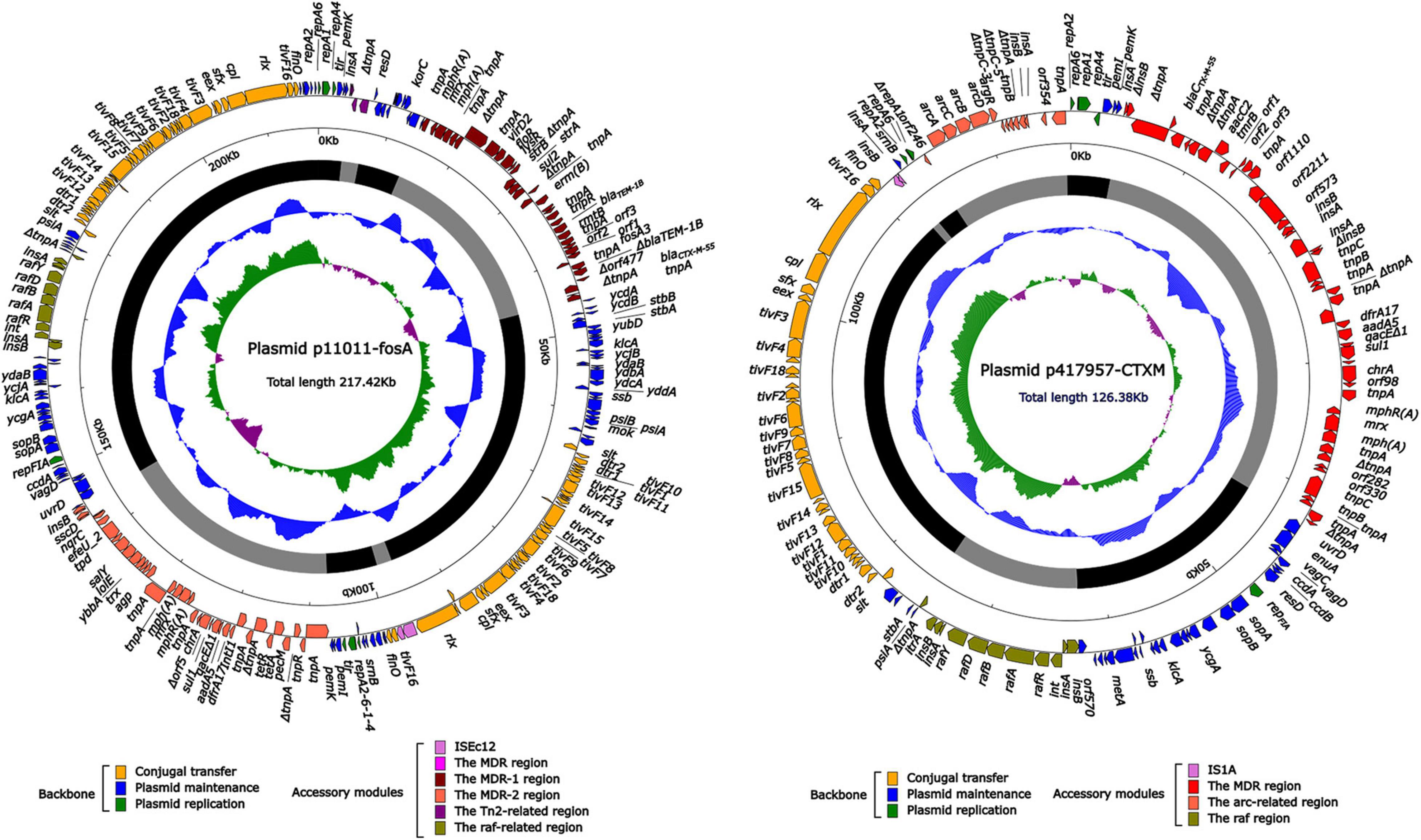
Figure 1. The complete sequence diagram of p11011-fosA and p417957-CTXM. Note: In the figure, the innermost ring represents (G-C)/(G + C); the blue ring indicates GC content, and the outward depression indicates that the GC content is higher than the mean value. Black area in the outer circle represents the backbone area and gray area represents the accessory modules. The outermost circle shows the distribution of genes represented by colored arrows in the plasmid.
Replicon repA2-6-1-4 of the Backbone Area
Comparing the sequences in the database revealed that both plasmids p11011-fosA and p417957-CTXM belonged to multi-replicon IncFII plasmids, which both contained the main replicon repA2-6-1-4 (Figure 2). The sequence of this gene was identical to the replication initiation region of the reference plasmid pHN7A8. p417957-CTXM also contained a repFIA replicon and the backbone area, including core butler genes (ccdAB, vagCD, sopAB, ycgA, klcA, and ssb) responsible for maintaining the stability of the plasmid. In addition to the main replicon repA2-6-1-4 and the auxiliary replicon repFIA, plasmid p11011-fosA also contained a replicon repA2-6-1-4 structure. The sequence of this structure was different from that of pHN7A8. Therefore, the plasmid was likely to be hybridized by two IncFII plasmids. The backbone area of p417957-CTXM had a conjugal transfer region similar to the reference plasmid pHN7A8, considering their nucleic acid alignment and expressed proteins. The plasmid p11011-fosA contained two conjugal transfer regions. Conjugal transfer proteins and flagella proteins promoted flagella production, which collectively facilitated horizontal transfer of plasmids between bacteria.

Figure 2. (A) Linear comparison of p11011-fosA with related plasmids. (B) Linear comparison of p417957-CTXM with related plasmids. Genes are indicated by arrows. Genes, mobile elements and other features are colored based on functional classification. Shadows indicate nucleotide homology is greater than 95%. p11011-fosA and p417957-CTXM were sequenced in this study, while the sequence of pHN7A8, p28078-NDM, and p61806-dfrA was from GenBank as reference plasmids.
Analysis of Multi-Drug Resistant Region in p11011-fosA and p417957-CTXM
As shown in Figure 3, the MDR-1 region of plasmid p11011-fosA consists of the following mobile elements: IS15DI-mph (A)-IS15DI unit [containing macrolide resistance gene mph (A)], ΔICEVchNep1_virable region III (containing florfenicol resistance gene floR, streptomycin resistance gene strAB, sulfonamides resistance gene sul2), IS15DI-erm (B)-IS15DI unit [macrolide resistance genes erm (B)], Tn2 remnant, IS26-fosA-IS26 unit (containing fosfomycin resistance gene fosA3), and ISEcp1-blaCTX–M–55-orf477 transposition unit (containing β-lactam antibiotic blaCTX–M–55). The MDR region of pHN7A8 was similar to the MDR-1 region of p11011-fosA, which contained fosfomycin resistance genes mediated by IS26 and aminoglycoside resistance genes mediated by Tn2.
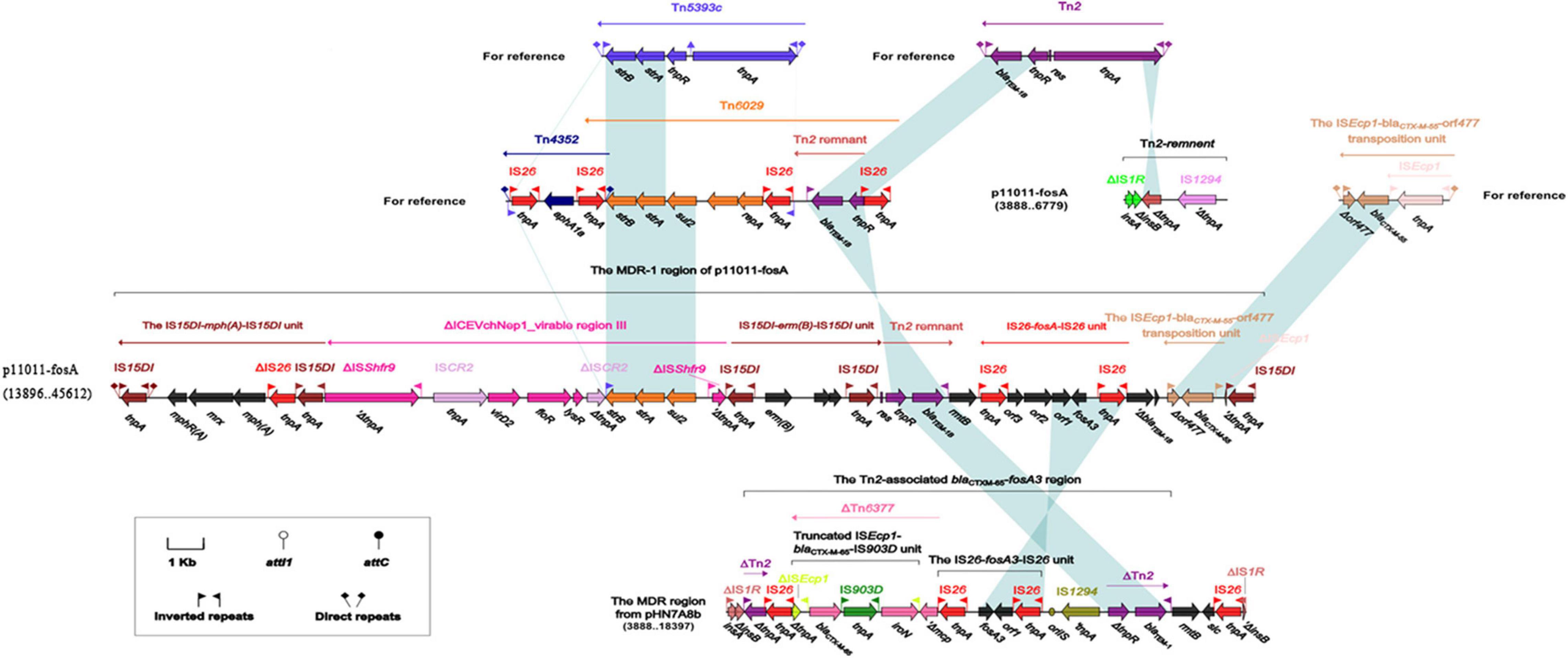
Figure 3. The MDR-1 region of p11011-fosA. Genes are indicated by arrows. Genes, mobile elements and other features are colored based on functional classification. Shadows indicate nucleotide homology is greater than 95%. The number in parentheses indicates the location of the fragment in the plasmid.
The MDR region of p417957-CTXM contained integron In54, IS26-mph (A)-mrx-mphR (A)-IS6100 unit, ISEcp1-blaCTX–M–55-orf477 transposition unit (containing β-lactamase resistance gene blaCTX–M–55), and aacC2-tmrB region (containing aminoglycoside resistance gene aacC2 and tunicamycin resistance gene tmrB).
The multi-drug resistance region MDR-2 of the plasmid p11011-fosA was composed of the following mobile elements in sequence: Tn5403, ΔTn1721 (containing tetracycline resistance gene tetAR), IS26, In54 (containing trimethoprim resistance gene drfA17, sulfonamides resistance gene sul1), IS26-mph(A)-mrx-mphR (A)-IS6100 unit (containing macrolide resistance genes), Tn3 family transposon remnant, Iron acquisition gene cluster, IS1R and IS1A (Figure 4). The typical structure of type 1 integron included IRi, 5 prime -CS, GCA, 3 prime -CS, Tn402 tni module, and IRt. In54 was a type I integron in both plasmids p11011-fosA and p417957-CTXM. The 5 prime -CS region contained integrase Intl1 responsible for the integration of capture resistance genes, and downstream of Intl1 contained trimethoprim resistance gene dfrA17 and aminoglycoside resistance gene aadA5. In addition, the 3 prime -CS region also contained sulfonamides resistance gene sul1. Moreover, the tni region of In54 was replaced by the chrA region, which was responsible for chromate particle transport. ChrA region was usually located in IS26-mph (A)-mrx-mphR (A)-IS6100 unit.
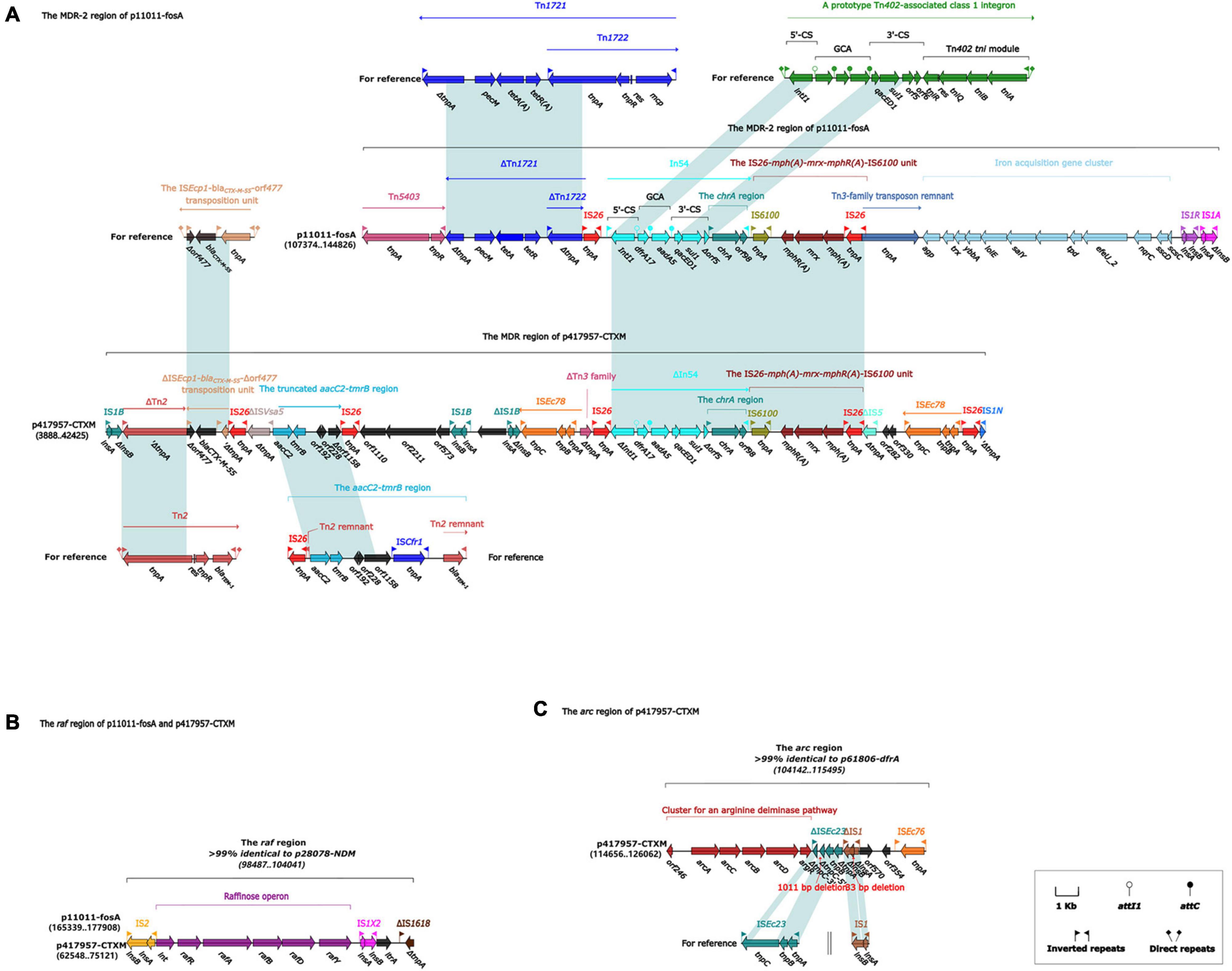
Figure 4. (A) The MDR-1 region of p11011-fosA and MDR region of p417957-CTXM. (B) The raf region of p110011-fosA and p417957-CTXM. (C) The arc region of p417957-CTXM. Genes are indicated by arrows. Genes, mobile elements, and other features are colored based on functional classification. Shadows indicate nucleotide homology is greater than 95%. The number in parentheses indicates the location of the fragment in the plasmid.
Discussion
In this study, E. coli strains isolated from the livestock and poultry breeding environment in Zhejiang Province showed high-level resistance (137/204) to extended-spectrum β-lactam antibiotics (Cefazolin, Ceftazidime, and Imipenem). These antibiotics are prevalently used for the treatment of infections caused by Enterobacteriaceae. Essentially, all ESBL producers demonstrated multi-drug resistance profiles and carried at least one ESBL resistance gene, especially blaTEM (94.89%) and blaCTX–M (92.7%). Among all the E. coli strains investigated in the current study, the prevalence of ESBL producers (67.2%) is quite close to that previously reported in Henan Province (60.8%) from 2007 to 2008 (Yuan et al., 2009). However, it is still lower than those reported in northeast China (Jilin, Liaoning, and Heilongjiang Provinces (100%) from 2011 to 2013 (Tong et al., 2015).
In this study, six extended-spectrum β-Lactamase resistance genes were detected in all antibiotic resistant strains, and blaCTX–M was the second common resistance gene. However, Tong et al. (2015) found that CTX-M-type ESBL resistance genes were the most common genotype of E. coli isolated from chickens in China. These contradictories may be due to different regions where the strains were isolated and various poultry species. However, it might be related to mobile genetic elements such as plasmids and transposons as well. Previous reports showed that CTX-M-encoding genes in E. coli, isolated from food animals, have a high diversity in China, and CTX-M-14 was the most widespread CTX-M enzyme, followed by CTX-M-55 (Zheng et al., 2012). blaCTX–M–55 has been widely reported in food-producing animals and pets in China (Rao et al., 2014). In this study, the strains carrying CTX-M-55-type ESBL showed different MDR profiles. In order to further study the mobile genetic elements related to CTX-M gene transfer, we selected two plasmids of two strains for sequencing and analysis.
We identified two conjunctive IncFII multi-resistance plasmids carrying blaCTX–M–55 and analyzed the genetic context of blaCTX–M–55 and MDR region. Most CTX-M genes were identified to be associated with IncFII or IncI1 plasmids (Carattoli, 2009; Cao et al., 2011). The most common IncFII type plasmid was F2:A-: B-, which had also been reported to be linked to blaCTX–M genes in Enterobacteriaceae strains isolated from other regions (Laura et al., 2010; Kim et al., 2011). In the current study, the IncFII plasmid p11011-fosA contains another ESBL resistance genes blaTEM–1B and fosfomycin resistance gene fosA3, while the other IncFII plasmid p417957-CTXM don’t have the two resistance genes. fosA3 is frequently co-transferred with blaCTX–M genes, and the dissemination of fosA3 may be related to the co-selection of cephalosporins (Hou et al., 2012). In previous epidemic plasmids, it was observed that the fosA3 gene is frequently co-transferred with blaCTX–M–14, blaCTX–M–55, blaCTX–M–65, floR, and rmtB genes. Thus, reducing the total use of antibiotics, especially cephalosporins, in livestock and poultry breeding environment contributes to controlling the dissemination of plasmid-mediated fosfomycin and β-Lactamase resistance genes (Yang et al., 2014).
In this study, we found that blaCTX–M–55 was located on the ISEcp1-blaCTX–M–55-orf477 transposition unit, which was similar to previous studies (Zheng et al., 2012). ISEcp1-blaCTX–M–55-orf477 transposition unit is a significant element in the propagation of blaCTX–M–55. ISEcp1 is bounded by 14-bp inverted repeats, with IRL at the left end of the transcription direction of the transposase gene and IRR at the right end. In addition, ISEcp1 uses IRL in conjunction with alternative sequences like these IR to mobilize adjacent regions, forming a 5-bp direct repeat (DR) on transposition (Poirel et al., 2005; Wachino et al., 2006). The MDR region in pHN7A8 and p11011-fosA is mainly formed by the insertion of mobile elements. The insertion of Tn2-rmtB element into the insB of IS1R results in only 214 bp residue in insB. The insertion of the region of 9.4 kb [IS26, Δ Tn6377, the IS26-fosA3-IS26 unit (Ho et al., 2013) and IS1294] between tnpA and tnpR of Tn2 leads to the loss of res site of Tn2. Tn2-rmtB element (Doi et al., 2008) and the variant of this element have been widely found in Enterobacteriaceae. Tn6377 was originally identified on the plasmid pKP96 (Shen et al., 2008) in Klebsiella pneumoniae, and the transposon was formed by inserting Tn1722 (Zong et al., 2011) into the ISEcp1 – blaCTX–M–65-IS 903D unit of the Tn3 family. Tn6377 in pHN7A8 is interrupted at both terminals by IS26.
The MGEs, such as transposons, play an essential role in the rapid spread of AMR by horizontal gene transfer due to the selective pressure imposed by antibiotics (Snesrud et al., 2018). Tn5403 found in MDR-2 region in plasmid p11011-fosA did not contain antibiotic resistance genes and was first identified in the plasmid of Klebsiella pneumoniae (Rinkel et al., 1994). Another transposon Tn1721 belongs to the transposon of the Tn21 family and has three 38 bp repeats and two transposase genes tnpA with the same sequence. There are tnpA, tnpR, res sites, and the gene mcp that encodes methyl-chemotactic proteins at one terminal, with 38 bp reverse repeats on both sides of this terminal. This terminal is named Tn1722 and can be moved independently. The rest of Tn1721 contains the tetracycline resistance gene tetA. Although Tn1721 in the MDR-2 region of p11011-fosA is interrupted by IS26 and Tn5403, the key tetracycline resistance gene in this transposon remains intact. IS26-mph (A)-mrx-mphR (A)-IS6100 unit is the carrier element for common macrolide resistance genes, which are usually located on resistant plasmids in E. coli (Partridge, 2011).
Conclusion
The presence of multiple mobile elements in a blaCTX–M-carrying multi-resistance plasmid makes it flexible. These elements aid its persistence and dissemination among E. coli and potentially other Gram-negative bacteria. This study demonstrated the abundance of β-lactamase resistance genes in livestock and poultry breeding environment in Zhejiang Province. It also upgraded the research on IncFII plasmids containing blaCTX–M antibiotic resistance genes in the NCBI database. This research also provided beta-lactam resistance profile of bacteria isolated from farms in Zhejiang Province, indicating that local farmers can possibly reduce the use of specific beta-lactam antibiotics to reduce the evolution of multi-resistant strains.
Data Availability Statement
Publicly available datasets were analyzed in this study. This data can be found here: https://www.ncbi.nlm.nih.gov/nuccore/NZ_MH454107.1 and https://www.ncbi.nlm.nih.gov/nuccore/NZ_MG764548. 1NCBI, GenBank accession numbers NZ_MH454107.1 and NZ_MG764548.1.
Author Contributions
WZ: visualization, data curation, software, and writing—original draft preparation. EZ: conceptualization, methodology, formal analysis, and writing—original draft preparation. JZ: visualization and investigation. ZH: software and writing—review and Editing. YZ: software and validation. JH: formal analysis and resources. DQ: conceptualization, resources, supervision, and writing—review and Editing. All authors contributed to the article and approved the submitted version.
Funding
This work was supported by the National Natural Science Foundation of China (No. 32172188).
Conflict of Interest
The authors declare that the research was conducted in the absence of any commercial or financial relationships that could be construed as a potential conflict of interest.
Publisher’s Note
All claims expressed in this article are solely those of the authors and do not necessarily represent those of their affiliated organizations, or those of the publisher, the editors and the reviewers. Any product that may be evaluated in this article, or claim that may be made by its manufacturer, is not guaranteed or endorsed by the publisher.
Acknowledgments
We gratefully acknowledge the reviewers for their constructive comments and suggestions.
Supplementary Material
The Supplementary Material for this article can be found online at: https://www.frontiersin.org/articles/10.3389/fmicb.2021.753979/full#supplementary-material
Footnotes
References
Abera, B., Kibret, M., and Mulu, W. (2016). Extended-Spectrum beta (β)-lactamases and antibiogram in Enterobacteriaceae from clinical and drinking water sources from bahir dar city, Ethiopia. PLoS One 11:e0166519. doi: 10.1371/journal.pone.0166519
Abraham, S., Kirkwood, R. N., Laird, T., Saputra, S., Mitchell, T., Singh, M., et al. (2018). Dissemination and persistence of extended-spectrum cephalosporin-resistance encoding IncI1-bla(CTXM–1) plasmid among Escherichia coli in pigs. ISME J. 12, 2352–2362. doi: 10.1038/s41396-018-0200-3
Blaak, H., Lynch, G., Italiaander, R., Hamidjaja, R. A., Schets, F. M., and de Roda Husman, A. M. (2015). Multidrug-Resistant and extended spectrum beta-lactamase-producing Escherichia coli in dutch surface water and wastewater. PLoS One 10:e0127752. doi: 10.1371/journal.pone.0127752
Boetzer, M., and Pirovano, W. (2012). Toward almost closed genomes with GapFiller. Genome Biol. 13:R56. doi: 10.1186/gb-2012-13-6-r56
Bolger, A. M., Lohse, M., and Usadel, B. (2014). Trimmomatic: a flexible trimmer for Illumina sequence data. Bioinformatics 30, 2114–2120.
Bradford, P. A. (2001). Extended-spectrum beta-lactamases in the 21st century: characterization, epidemiology, and detection of this important resistance threat. Clin. Microbiol. Rev. 14:933. doi: 10.1128/CMR.14.4.933-951.2001
Cao, X., Cavaco, L. M., Lv, Y., Li, Y., Zheng, B., Wang, P., et al. (2011). Molecular characterization and antimicrobial susceptibility testing of Escherichia coli isolates from patients with urinary tract infections in 20 Chinese hospitals. J. Clin. Microbiol. 49, 2496–2501. doi: 10.1128/jcm.02503-10
Carattoli, A. (2009). Resistance plasmid families in Enterobacteriaceae. Antimicrob. Agents Chemother. 53, 2227–2238. doi: 10.1128/aac.01707-08
Chajȩcka-Wierzchowska, W., Zadernowska, A., Nalepa, B., Sierpińska, M., and Laniewska-Trokenheim, L. (2014). Retail ready-to-eat food as a potential vehicle for Staphylococcus spp. harboring antibiotic resistance genes. J. Food Prot. 77, 993–998. doi: 10.4315/0362-028x.Jfp-13-466
Doi, Y., Adams-Haduch, J. M., and Paterson, D. L. (2008). Escherichia coli Isolate Coproducing 16S rRNA Methylase and CTX-M-Type Extended-Spectrum β-Lactamase Isolated from an Outpatient in the United States. Antimicrob. Agents Chemother. 52, 1204–1205. doi: 10.1128/AAC.01320-07
Goldstein, C., Lee, M., Sanchez, S., Hudson, C., Phillips, B., Register, B., et al. (2001). Incidence of class 1 and 2 integrases in clinical and commensal bacteria from livestock, companion animals, and exotics. Antimicrob. Agents Chemother. 45, 723–726. doi: 10.1128/AAC.45.3.723-726.2001
Ho, P. L., Chan, J., Lo, W. U., Law, P. Y., Li, Z., Lai, E. L., et al. (2013). Dissemination of plasmid-mediated fosfomycin resistance fosA3 among multidrug-resistant Escherichia coli from livestock and other animals. J. Appl. Microbiol. 114, 695–702. doi: 10.1111/jam.12099
Hong, S. S., Kyeongmi, K., Young, H. J., Bochan, J., Kang, M. S., and Hong, S. G. (2012). Multiplex PCR for rapid detection of genes encoding Class A Carbapenemases. Ann. Lab. Med. 32, 359–361. doi: 10.3343/alm.2012.32.5.359
Hou, J., Huang, X., Deng, Y., He, L., Yang, T., Zeng, Z., et al. (2012). Dissemination of the fosfomycin resistance gene fosA3 with CTX-M β-lactamase genes and rmtB carried on IncFII plasmids among Escherichia coli isolates from pets in China. Antimicrob. Agents Chemother. 56, 2135–2138. doi: 10.1128/aac.05104-11
Institute CLSI (2018). Performance Standards for Antimicrobial Susceptibility Testing—Twenty-Eighth Edition: M100”. Wayne, PA: CLSI.
Kanayama, A., Iyoda, T., Matsuzaki, K., Saika, T., Ikeda, F., Ishii, Y., et al. (2010). Rapidly spreading CTX-M-type beta-lactamase-producing Proteus mirabilis in Japan. Int. J. Antimicrob. Agents 36, 340–342. doi: 10.1016/j.ijantimicag.2010.06.002
Kim, J., Bae, I. K., Jeong, S. H., Chang, C. L., Lee, C. H., and Lee, K. (2011). Characterization of IncF plasmids carrying the blaCTX–M–14 gene in clinical isolates of Escherichia coli from Korea. J. Antimicrob. Chemother. 66, 1263–1268.
Lane, D. J. (1991). “16S/23S rRNA sequencing,” in Nucleic Acid Techniques in Bacterial Systematics, eds E. Stackebrandt and M. Goodfellow (New York, NY: John Wiley and Sons).
Laura, V., Aurora, G. F., Daniela, F., and Alessandra, C. (2010). Replicon sequence typing of IncF plasmids carrying virulence and resistance determinants. J. Antimicrob. Chemother. 65, 2518–2529. doi: 10.1093/jac/dkq347
Liao, X. P., Xia, J., Yang, L., Li, L., Sun, J., Liu, Y. H., et al. (2015). Characterization of CTX-M-14-producing Escherichia coli from food-producing animals. Front. Microbiol. 6:1136. doi: 10.3389/fmicb.2015.01136
Nederbragt, A. J. (2014). On the middle ground between open source and commercial software-the case of the Newbler program. Genome Biol. 15, 1–2. doi: 10.1186/gb4173
Partridge, S. R. (2011). Analysis of antibiotic resistance regions in Gram-negative bacteria. Fems Microbiol. Rev. 35, 820–855.
Paterson, D. L., and Bonomo, R. A. (2005). Extended-spectrum beta-lactamases: a clinical update. Clin. Microbiol. Rev. 18, 657–686. doi: 10.1128/cmr.18.4.657-686.2005
Poirel, L., Lartigue, M. F., Decousser, J. W., and Nordmann, P. (2005). ISEcp1B-mediated transposition of blaCTX–M in Escherichia coli. Antimicrob. Agents Chemother. 49, 447–450. doi: 10.1128/aac.49.1.447-450.2005
Rao, L., Lv, L., Zeng, Z., Chen, S., He, D., Chen, X., et al. (2014). Increasing prevalence of extended-spectrum cephalosporin-resistant Escherichia coli in food animals and the diversity of CTX-M genotypes during 2003-2012. Vet. Microbiol. 172, 534–541. doi: 10.1016/j.vetmic.2014.06.013
Rinkel, M., Hubert, J. C., Roux, B., and Lett, M. C. (1994). Identification of a new transposon Tn5403 in a Klebsiella pneumoniae strain isolated from a polluted aquatic environment. Curr. Microbiol. 29:249.
Sajjad, A., Holley, M. P., Labbate, M., Stokes, H. W., and Gillings, M. R. (2011). Preclinical class 1 integron with a complete Tn402-like transposition module. Appl. Environ. Microbiol. 77, 335–337. doi: 10.1128/aem.02142-10
Shen, P., Jiang, Y., Zhou, Z., Zhang, J., Yu, Y., and Li, L. (2008). Complete nucleotide sequence of pKP96, a 67 850 bp multiresistance plasmid encoding qnrA1, aac(6’)-Ib-cr and blaCTX–M–24 from Klebsiella pneumoniae. J. Antimicrob. Chemother. 62, 1252–1256. doi: 10.1093/jac/dkn397
Sivaraman, G. K., Rajan, V., Vijayan, A., Elangovan, R., Prendiville, A., and Bachmann, T. T. (2021). Antibiotic resistance profiles and molecular characteristics of extended-spectrum beta-lactamase (ESBL)-producing Escherichia coli and Klebsiella pneumoniae isolated from shrimp aquaculture farms in Kerala, India. Front. Microbiol. 12:622891. doi: 10.3389/fmicb.2021.622891
Snesrud, E., Mcgann, P., and Chandler, M. (2018). The birth and demise of the is Apl1 - mcr-1 -IS Apl1 composite transposon: the vehicle for transferable colistin resistance. mBio 9, e2381–e2417. doi: 10.1128/mBio.02381-17
Stokes, H. W., and Hall, R. M. (1989). A novel family of potentially mobile DNA elements encoding site-specific gene-integration functions: integrons. Mol. Microbiol. 3, 1669–1683. doi: 10.1111/j.1365-2958.1989.tb00153.x
Tong, P., Sun, Y., Ji, X., Du, X., Guo, X., Liu, J., et al. (2015). Characterization of antimicrobial resistance and extended-spectrum β-lactamase genes in Escherichia coli isolated from chickens. Foodborne Pathog. Dis. 12:345.
Wachino, J., Yamane, K., Kimura, K., Shibata, N., Suzuki, S., Ike, Y., et al. (2006). Mode of transposition and expression of 16S rRNA methyltransferase gene rmtC accompanied by ISEcp1. Antimicrob. Agents Chemother. 50, 3212–3215. doi: 10.1128/aac.00550-06
Wellington, E. M., Boxall, A. B., Cross, P., Feil, E. J., Gaze, W. H., Hawkey, P. M., et al. (2013). The role of the natural environment in the emergence of antibiotic resistance in gram-negative bacteria. Lancet Infect. Dis. 13, 155–165. doi: 10.1016/s1473-3099(12)70317-1
Yang, X., Liu, W., Liu, Y., Wang, J., Lv, L., Chen, X., et al. (2014). F33: A-: B-, IncHI2/ST3, and IncI1/ST71 plasmids drive the dissemination of fosA3 and blaCTX–M–55/–14/–65 in Escherichia coli from chickens in China. Front. Microbiol. 5:688. doi: 10.3389/fmicb.2014.00688
Yano, Y., Hamano, K., Satomi, M., Tsutsui, I., Ban, M., and Aueumneoy, D. (2014). Prevalence and antimicrobial susceptibility of Vibrio species related to food safety isolated from shrimp cultured at inland ponds in Thailand. Food Control 38, 30–36.
Yuan, L., Liu, J. H., Hu, G. Z., Pan, Y. S., Liu, Z. M., Mo, J., et al. (2009). Molecular characterization of extended-spectrum beta-lactamase-producing Escherichia coli isolates from chickens in Henan Province, China. J. Med. Microbiol. 58, 1449–1453. doi: 10.1099/jmm.0.012229-0
Zheng, H., Zeng, Z., Sheng, C., Liu, Y., and Liu, J. H. (2012). Prevalence and characterisation of CTX-M β-lactamases amongst Escherichia coli isolates from healthy food animals in China. Int. J. Antimicrob. Agents 39, 305–310.
Keywords: plasmid, β-Lactam antibiotics, blaCTX–M, MDR, mobile elements
Citation: Zhou W, Zhang E, Zhou J, He Z, Zhou Y, Han J and Qu D (2021) Characterization and Comparative Genomics Analysis of lncFII Multi-Resistance Plasmids Carrying blaCTX–M and Type1 Integrons From Escherichia coli. Front. Microbiol. 12:753979. doi: 10.3389/fmicb.2021.753979
Received: 05 August 2021; Accepted: 29 October 2021;
Published: 16 November 2021.
Edited by:
Henrietta Venter, University of South Australia, AustraliaReviewed by:
Piklu Roy Chowdhury, University of Technology Sydney, AustraliaXiaoqiang Liu, Northwest A&F University, China
Copyright © 2021 Zhou, Zhang, Zhou, He, Zhou, Han and Qu. This is an open-access article distributed under the terms of the Creative Commons Attribution License (CC BY). The use, distribution or reproduction in other forums is permitted, provided the original author(s) and the copyright owner(s) are credited and that the original publication in this journal is cited, in accordance with accepted academic practice. No use, distribution or reproduction is permitted which does not comply with these terms.
*Correspondence: Daofeng Qu, ZGFvZmVuZ0BtYWlsLnpqZ3N1LmVkdS5jbg==
†These authors have contributed equally to this work
 Wei Zhou1†
Wei Zhou1† Daofeng Qu
Daofeng Qu
